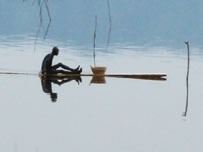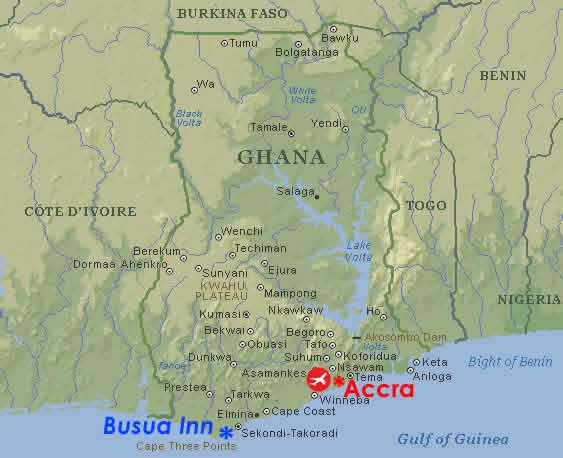| |
Ghana
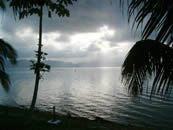 |
| Lake Bosumtwi |
The Republic of Ghana is a nation in West Africa.
It borders the Ivory Coast to the west, Burkina Faso in the north
and Togo to the east. It was inhabited in pre-colonial times by
a number of ancient kingdoms, including an inland Ashanti kingdom
and various Fante states along the coast. Trade with European states
flourished after contact with the Portuguese in the 15th century,
and the British established a crown colony, Gold Coast, in 1874.
Ghana became independent in 1957. Accra is the capital and largest
city. The country's population in 2005 was 21,029,853. It was the
first African country to obtain its independence from Britain.
Name
Upon achieving independence
from the United Kingdom, the name "Ghana" was
chosen for the new nation—a reference to the Ghana Empire
of earlier centuries. This name is mostly symbolic, as the ancient
Empire of Ghana was located to the north and west of current-day
Ghana. The name was adopted as a reference to the descendants of
the ancient Empire of Ghana who migrated south and east and currently
reside in Ghana.
History
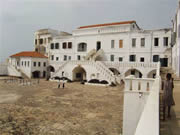 |
| Cape Coast castle |
Formed from the merger of the British colony Gold Coast and the
British Togoland trust territory by a U.N. sponsored plebiscite,
Ghana in 1957 became the first sub-Saharan country in colonial
Africa to gain its independence. A long series of coups ended with
the ascension to power of Flight Lieutenant Jerry Rawlings in 1981.
His changes resulted in the suspension of the constitution in 1981
and the banning of political parties. A new constitution, restoring
multiparty politics, was approved in 1992, and Rawlings was elected
in free elections of that year and also in 1996. The constitution
prohibited him from running for a third term. John Kufuor, the
current president, is now in his second term.
Economy
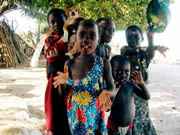 |
| Future of Ghana |
Well endowed with natural resources, Ghana has twice the per capita
output of the poorer countries in West Africa. Even so, Ghana remains
heavily dependent on international financial and technical assistance.
Gold, timber, and cocoa production are major sources of foreign
exchange.
The domestic economy continues to revolve around subsistence agriculture,
which accounts for 40% of GDP and employs 60% of the work force,
mainly small landholders. In 1995-97, Ghana made mixed progress
under a three-year structural adjustment program in cooperation
with the IMF. On the minus side, public sector wage increases and
regional peacekeeping commitments have led to continued inflationary
deficit financing, depreciation of the cedi, and rising public
discontent with Ghana's austerity measures.
Geography
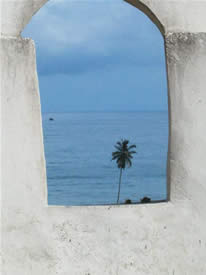 |
| St lago Castle in Elmina |
Ghana is located on
the Gulf of Guinea, only a few degrees north of the Equator.
It is roughly the size of the state of Oregon. The coastline
is mostly a low, sandy shore backed by plains and scrub and intersected
by several rivers and streams. A tropical rain forest belt, broken
by heavily forested hills and many streams and rivers, extends
northward from the shore. North of this belt, the land is covered
by low bush, park-like savanna, and grassy plains.
The climate is tropical. The eastern coastal belt is warm and
comparatively dry ; the southwest corner, hot
and humid; and the north, hot and dry. Lake Volta, the largest
reservoir in the world, extends through large portions of eastern
Ghana.
Culture
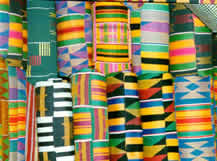 |
| Kente Cloth |
Perhaps the most visible (and most marketable) cultural contribution
from modern Ghana is Kente cloth, which is widely recognized and
valued for its colors and symbolism. Kente cloth is made by skilled
Ghanaian weavers, and the major weaving centers in and around Kumasi
(Bonwire is known as the home of Kente, though areas of Volta Region
also lay claim to the title) are full of weavers throwing their
shuttles back and forth as they make long strips of Kente. These
strips can then be sewn together to form the larger wraps which
are worn by some Ghanaians (chiefs especially) and are purchased
by tourists in Accra and Kumasi. The colors and patterns of the
Kente are carefully chosen by the weaver and the wearer. Each symbol
woven into the cloth has a special meaning within Ghanaian culture.
Kente is
one of the symbols of the Ghanaian chieftaincy, which remains
strong throughout the south and central regions of the
country, particularly in the areas populated by members of the
culturally- and politically-dominant Ashanti tribe. The Ashanti's
chief, known as the Asantehene, is perhaps the most revered individual
in the central part of the country. Like other Ghanaian chiefs,
he wears bright Kente, gold bracelets, rings and amulets, and
is always accompanied by numerous ornate umbrellas (which are
also
a symbol of the chieftaincy itself). The most sacred symbol of
the Ashanti people is the Golden Stool, a small golden throne
in which the spirit of the people is said to reside. It is kept
in
safekeeping in Kumasi, the cultural capital of the Ashanti people
and the seat of the Asantehene's palace. Though the chieftaincy
across Ghana has been weakened by allegations of corruption and
cooperation with colonial oppression, it remains a very vital
institution in Ghana.
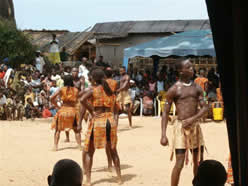 |
| Funeral in Busua |
Because
of its location, the northern regions of Ghana exhibit
cultural ties with other Sahelian countries such as Burkina
Faso,
Mali and northern Nigeria. Although not being indigenous tribes
to the area, there is strong Hausa and Mande influence in the
culture of the northern Ghanaian peoples. The dominant tribe
in this part
of Ghana are the Dagomba. Northern Ghanaians are known for their
traditional long flowing robes and distinct musical styles from
southern and central regions. A speciality of food from this
region which has successfully become a staple across Ghana
is Tuo Zaafi,
which is made from pounded rice. The Larabanga mosque in Larabanga
is the oldest mosque in Ghana and one of the oldest in West Africa,
dating from the 12th century. It is an excellent example of the
Sudanese Architecture style, of which other examples include
the Djenne mosque in Mali and the Grand Mosque in Agadez,
Niger.
After Independence, the Ghanaian music scene flourished, particularly
the up-tempo, danceable style known as high life, which is still
played consistently at the local clubs and bars, often called spots.
Many Ghanaians are adept drummers, and it is not unusual to hear
traditional drum ensembles play at social events or performances.
Currency
Ghanaian currency is Ghana Cedi (1 US $ is almost 1 ghana cedi). Take care, many ghanaians still talk in old cedis (1 Ghana cedi= 10,000 old cedis) without saying "thousands", so when they say one hundred it usually means 10 Ghana cedis.
(Source: Wikipedia)
|

